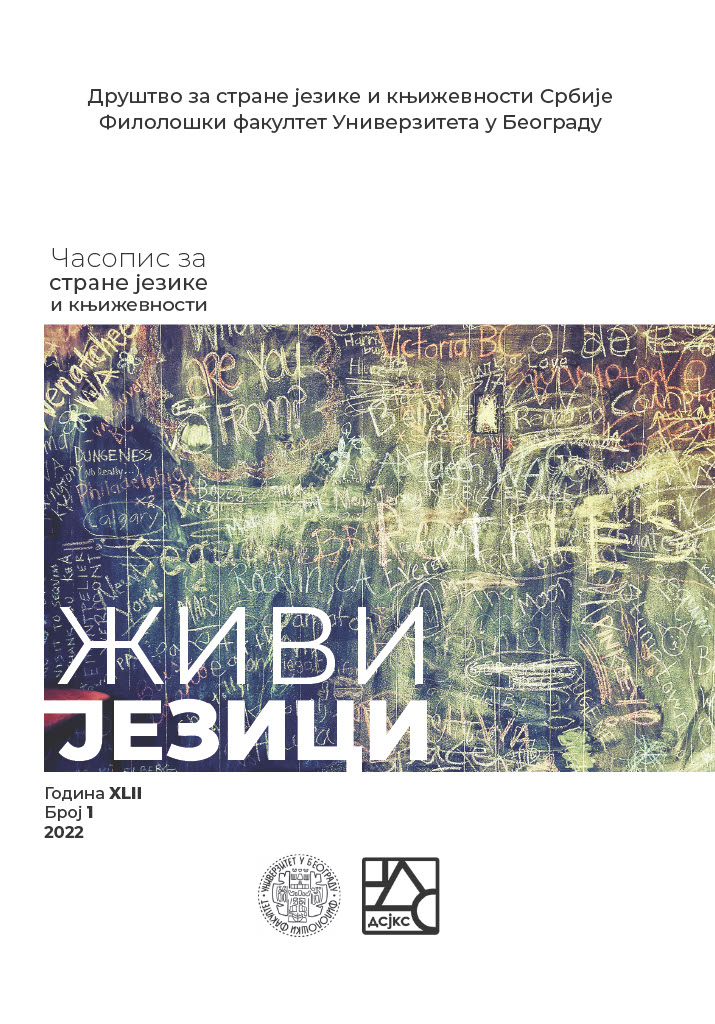The determining factors in the formation of the Italian alphabet
DOI:
https://doi.org/10.18485/zivjez.2022.42.1.4Keywords:
grapheme-phoneme correspondence (GPC), Neo-Romance phonemes, Latin alphabet, alphabet reform, orthographyAbstract
This paper describes the main historical factors that have influenced the form of the Italian alphabet as we know it today and the reasons for its persistency in maintaining its incomplete orthographic transparency. The analysis is carried out following a chronological order, i.e., starting from the form of the Latin alphabet and then describing the problem of neo-Romance phonemes and the various graphic solutions of the medieval manuscripts. The paper then moves on to the centuries-long process of language standardization and the question of the literary authorities, which, naturally, also influenced the orthographic choices. A part of the analysis is dedicated to the attempts of reforming the alphabet and the reasons why they were never taken on. The aforementioned elements lead us to the conclusion that the conservatism of the Italian writing is due to the continuous presence of the authority of the Latin heritage, and consequently to the prestige attributed to the Latin forms, which do not allow orthographic innovations and force the language to keep within the confines of the existing alphabet.
References
Bembo 1989: P. Bembo, Prose della volgar lingua, Gli Asolani, Rime, prir. Carlo Dionisotti. Milano: I classici italiani TEA tascabili Editori Associati, 1989. [https://liberliber.it]
Bokačo 2014: G. Boccaccio, Decameron, 4 ed., prir. Vitore Branka. Torino: Einaudi.
Čurčić 1974: L. Čurčić, Stare srpske štamparije u Turskoj i Austriji. Beograd: b.i.
D’Akile 2003: P. D’Achille, Breve grammatica storica dell’italiano. Roma: Carocci editore.
D’Akile 2011a: P. D’Achille, Norma linguistica. In Enciclopedia dell’italiano [Online], [https://www.treccani.it/enciclopedia/norma-linguistica_(Enciclopedia-dell'Italiano)/]
D’Akile 2011b: P. D’Achille, Trissino, Gian Giorgio. In Enciclopedia dell’italiano [Online], [https://www.treccani.it/enciclopedia/gian-giorgio-trissino_(Enciclopedia-dell'Italiano)/]
D’Akile 2019: P. D’Achille, Qual è il problema? L’ortografia!. In Accademia della Crusca [Online] [https://accademiadellacrusca.it/it/contenuti/qual--il-problema-lortografia/7435]
De Blazi 2011: N. De Blasi, Scuola e lingua. In Enciclopedia dell’italiano [Online], [https://www.treccani.it/enciclopedia/scuola-e-lingua_(Enciclopedia-dell'Italiano)/]
Demartini 2010: S. Demartini, Alfabeto. In Enciclopedia dell’italiano [Online], [https://www.treccani.it/enciclopedia/alfabeto_(Enciclopedia-dell'Italiano)/]
Demartini 2011: S. Demartini, Ortografia. In Enciclopedia dell’italiano [Online], [https://www.treccani.it/enciclopedia/ortografia_%28Enciclopedia-dell%27Italiano%29/]
Ferroni 1992: G. Ferroni, Profilo storico della letteratura italiana, I vol. Milano: Mondadori.
Gortan, Gorski i Pauš 1971: V. Gortan, O. Gorski, P. Pauš, Latinska gramatika. Zagreb: Školska knjiga.
Mani 2016: P. Manni, La lingua di Boccaccio. Bologna: Il Mulino.
Maracini 1994: C. Marazzini, La lingua italiana. Profilo storico. Bologna: Il Mulino.
Maraskijo 1994: N. Maraschio, Grafia e ortografia: evoluzione e codificazione. In L. Serianni e P. Trifone (a cura di), Storia della lingua italiana (pp. 139–227). Torino: Einaudi.
Maturi i Leoni 2003: P. Maturi i F. A. Leoni, Manuale di fonetica. Roma: Carocci editore
Milinković 2011: S. Milinković, Dekameron: knjiga o ljubavi. Beograd: Arhipelag.
Miljorini 2007: B. Migliorini, Storia della lingua italiana, 12 ed. Milano: Bompiani.
Novak 1987: V. Novak, Latinska paleografija. Beograd: Naučna knjiga.
Palermo 2016: M. Palermo, Linguistica italiana. Bologna: Il Mulino.
Presuti 2021a: S. Presutti, The Development of Latin alphabet identity markers: A comparison among three Romance graphemes, Lingua, 259, 103–118.
Presuti 2021b: S. Presutti, Graphemic Complexity for the New Romance Phonemes in Italian. Some Reflections. In Y. Haralambous (ed.). Grapholinguistics in the 21st century (pp. 755–773). Brest: Fluxus Editions.
Stojanović 1924: Lj. Stojanović, Život i rad Vuka Stefanovića Karadzića. Beograd/Zemun: Štamparija grafičkog zavoda ,,Makarije”.
Valeri 2001: V. Valeri, La scrittura. Storie e modelli. Roma: Carocci editore.
Published
How to Cite
Issue
Section
License
Copyright (c) 2022 Ana Živković

This work is licensed under a Creative Commons Attribution-NonCommercial-ShareAlike 4.0 International License.


